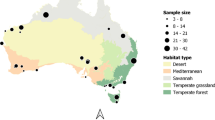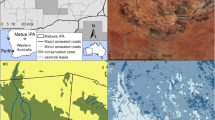Abstract
The introduced feral cat (Felis catus) is a widespread generalist with flexible social behaviour and an apex predator without major interspecific competitors in insular ecosystems that evolved in the absence of predators. Mechanistic definitions consider an animal’s home range to be the spatial expression of a cognitive map that is kept up-to-date with the status of critical resources that contribute to animal fitness. We assumed there are two major determinants structuring the home range of cats as apex predators in insular ecosystems: the distribution of critical food resources and conspecific distribution. We hypothesized that cats structure their home ranges by optimizing the use of staple critical food resources and that as a consequence of the presence of rich resources cats tend to socialise, aggregate and share space. We carried out spatial analyses using location data for feral cats tracked using lightweight GPS collars in conjunction with the suitability value of rabbit patches and their associated ownership costs for cats within a New Zealand braided-river environment. Cat home ranges and spatial distribution, especially for females, were related to the inclusion of rabbit patches within home ranges with higher mean value than the average of neighbourhood patches in the landscape. Cats showed solitary behaviour but tolerance to conspecific presence by sharing high-use areas and high-value rabbit patches, mostly at different times, resulting in occasional encounters among males and females. Home range size and patterns of spatial overlap were dependant on sex and season. Solitary spacing patterns as consequence of innate preferences together with resource constraints may regulate feral cat population densities.

Similar content being viewed by others
References
Adams ES (2001) Approaches to the study of territory size and shape. Annu Rev Ecol Evol S 32:277–303
Berkeley EP (1982) Maverick cats: encounters with feral cats. Walker, New York
Bingham BB, Noon BR (1997) Mitigation of the habitat “Take”: application to habitat conservation planning. Conserv Biol 11:127–139
Bjørneraas K, Van Moorter B, Rolandsen CM, Herfindal I (2010) Screening global positioning system location data for errors using animal movement characteristics. J Wildl Manag 74:1361–1366
Börger L, Dalziel BD, Fryxel JM (2008) Are there general mechanisms of animal home range behaviour? A review of prospects for future research. Ecol Lett 11:637–650
Bradshaw JWS (1992) The behaviour of the domestic cat. C.A.B.. International, Wallingford
Brown JL, Orians GH (1970) Spacing patterns in mobile animals. Ann Rev Ecol Evol S 1:239–262
Burt WH (1943) Territoriality and home range concepts as applied to mammals. J Mammal 24:346–352
Courchamp F, Chapuis JL, Pascal M (2003) Mammal invaders on islands: impact, control and control impact. Biol Rev 78:347–383
Crowell-David S, Curtis TM, Knowles RJ (2004) Social organization in the cat: a modern understanding. J Feline Med Surg 6:19–28
Denny E, Yakovlevich P, Eldridge MDB, Dickman C (2002) Social and genetic analysis of a population of free-living cats (Felis catus L.) exploiting a resource-rich habitat. Wildl Res 29:405–413
Development Core Team R (2008) R: A language and environment for statistical computing. R Foundation for Statistical Computing, Vienna
Ebensperger LA, Sobrero R, Quirici V, Castro RA, Tolhuysen LO, Vargas F, Burger JR, Quispe R, Villavicencio CP, Vásquez RA, Hayes LD (2012) Ecological drivers of group living in two populations of the communally rearing rodent. Behav Ecol Sociobiol 66:261–274
Elith J, Phillips S, Hastie T, Dudík M, Chee YE, Yates CJ (2011) A statistical explanation of MaxEnt for ecologist. Divers Distrib 17:43–57
Fitzgerald BM, Karl BJ (1986) Home range of feral house cats (Felis catus L.) in forests of the Orongorongo Valley, Wellington, New Zealand. New Zeal J Ecol 9:71–81
Getz WM, Fortmann-Roe S, Cross PC, Lyons LJ, Ryan SJ, Wilmers CC (2007) LoCoH: nonparameteric kernel methods for constructing home ranges and utilization distributions. PLoS One 2:e207
Gillies C, Fitzgerald BM (2005) The feral cat. In: King CM (ed) The handbook of New Zealand mammals. Oxford University Press, Melbourne, pp 294–307
Harper G (2004) Feral cats on Stewart Island/Rakiura. Department of Conservation Science Internal Series, Wellington, p 174
Hui C (2006) Carrying capacity, population equilibrium and environment’s maximum load. Ecol Model 192:317–320
Hurford A (2009) GPS measurement error gives rise to spurious 180° turning angles and strong directional biases in animal movement data. PLoS One 4:e5632
IUCN (2012) Red list of threatened species. www.iucnredlist.org. Accessed 26 Sept 2012
Jerde CL, Visscher DR (2005) GPS measurement error influences on movement model parameterization. Ecol Appl 15:806–810
Johnson DDP, Kays R, Blackwell PG, Macdonald D (2002) Does the resource dispersion hypothesis explain group-living? Trends Ecol Evol 17:563–570
Kernohan BJ, Gitzen RA, Millspaugh JJ (2001) Analysis of animal space use and movements. In: Millspaugh JJ, Marzluff JM (eds) Radiotracking and animal populations. Academic Press, San Diego, pp 126–166
King CM (2005) Editor’s Introduction. In: King CM (ed) The handbook of New Zealand mammals. Oxford University Press, Melbourne, pp 1–25
Krause J, Ruxton GD (2002) Living in groups. Oxford University Press, Oxford
Krebs JR, Davies NB (1997) Behavioural ecology: an evolutionary approach. Blackwell, Oxford, UK
Kristensson PO, Dahlbäck N, Anundi D, Björnstad M, Gillberg H, Haraldsson J, Mårtensson I, Nordvall M, Ståhl J (2009) An evaluation of space time cube representation of spatiotemporal patterns. IEEE Trans Vis Comput Graph 15:696–702
Liberg O (1980) Spacing patterns in a population of rural free roaming domestic cats. Oikos 35:336–349
Liberg O, Sandell M, Pontier D, Natoli E (2000) Density, spatial organisation and reproductive tactics in the domestic cat and other felids. In: Turner DC, Bateson P (eds) The domestic cat: the biology of its behaviour. Cambridge University Press, Cambridge, pp 119–147
Lindstedt SL, Miller BJ, Buskirk SW (1986) Home range, time, and body size in mammals. Ecology 67:413–418
Liu C, White M, Newell G (2013) Selecting thresholds for the prediction of species occurrence with presence-only data. J Biogeogr 40:778–789
Macdonald DW (1983) The ecology of carnivore social behaviour. Nature 301:379–384
Mohr CO, Stumpf WA (1966) Comparison of methods for calculating areas of animal activity. J Wildl Manag 30:293–304
Moller H, Alterio N (1999) Home range and spatial organisation of stoats (Mustela erminea), ferrets (Mustela futo) and feral house cats (Felis catus) on coastal grasslands, Otago Peninsula, New Zealand: implications for yellow-eyed penguin (Megadyptes antipodes) conservation. New Zeal J Ecol 26:165–174
Natoli E, De Vito E (1994) The mating system of feral cats living in a group. In: Turner D, Bateson P (eds) The domestic cat: the biology of its behaviour. Cambridge University Press, Cambridge, pp 99–108
Norbury G, Reddiex B (2005) European rabbit. In: King C (ed) The handbook of New Zeland mammals. Oxford University Press, Melbourne, pp 131–158
Norbury GL, Norbury DC, Heyward RP (1998) Space use and denning behaviour of wild ferrets (Mustela furo) and cats (Felis catus). New Zeal J Ecol 22(2):149–159
Phillips SJ, Anderson RP, Schapire RE (2006) Maximum entropy modelling of species geographic distributions. Ecol Model 190:231–259
Powell RA, Mitchel M (2012) What is a home range? J Mammal 93:948–958
Recio MR (2011) Spatial ecology of introduced mammalian predators in New Zealand: using satellite technology to quantify resource selection. Ph.D. thesis, University of Otago, Otago
Recio MR, Mathieu R, Denys P, Sirguey P, Seddon PJ (2011) Lightweight GPS-tags, one giant leap for wildlife tracking? An Assessment Approach. PLoS ONE 6:e28225
Revilla E (2003) Moving beyond the resource dispersion hypothesis. Trends Ecol Evol 18(8):380
SAS Institute Inc (2008) SAS/STAT® 9.2 user’s guide. SAS Institute, Inc, Cary
Say L, Pontier D (2004) Spacing pattern in a social group of stray cats: effects on male reproductive success. Anim Behav 68:175–180
Sol D (2008) Do successful invaders exist? Pre-adaptations to novel environments in terrestrial vertebrates. In: Nentwig W (ed) Biological invasions. Springer, Berlin, pp 127–141
Sunquist ME, Sunquist F (2002) Wild cats of the world. University of Chicago Press, Chicago
Zar JH (2009) Biostatistical analysis. Prentice Hall, Upper Saddle River
Acknowledgments
We thank Richard Maloney and the Department of Conservation staff in Twizel for the logistic support; Simon Stevenson for the assistance in the field; Godley Peaks and Lylibank Station for access permission to their lands; Emilio Virgós for providing helpful discussions and assistance. This project was funded by a Department of Zoology Research Grant (PJS) and School of Surveying Research Funds (PBRF). Mariano R. Recio was funded by a University of Otago Ph.D. scholarship.
Ethical standards
All experiments reported in this article comply with the current laws of New Zealand, where the study was performed under the University of Otago Animal Ethics Approval 14/08..
Author information
Authors and Affiliations
Corresponding author
Additional information
Communicated by K. E. Ruckstuhl
Rights and permissions
About this article
Cite this article
Recio, M.R., Seddon, P.J. Understanding determinants of home range behaviour of feral cats as introduced apex predators in insular ecosystems: a spatial approach. Behav Ecol Sociobiol 67, 1971–1981 (2013). https://doi.org/10.1007/s00265-013-1605-7
Received:
Revised:
Accepted:
Published:
Issue Date:
DOI: https://doi.org/10.1007/s00265-013-1605-7




